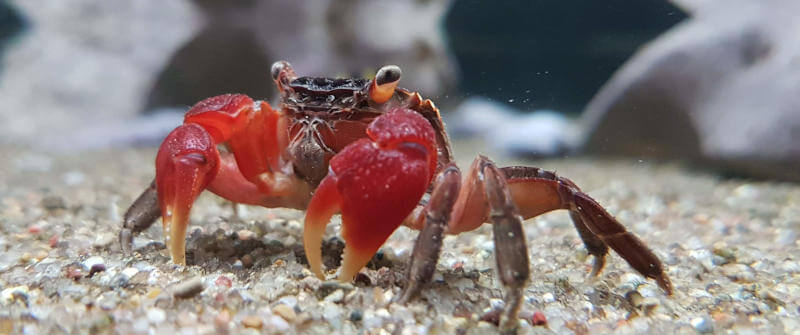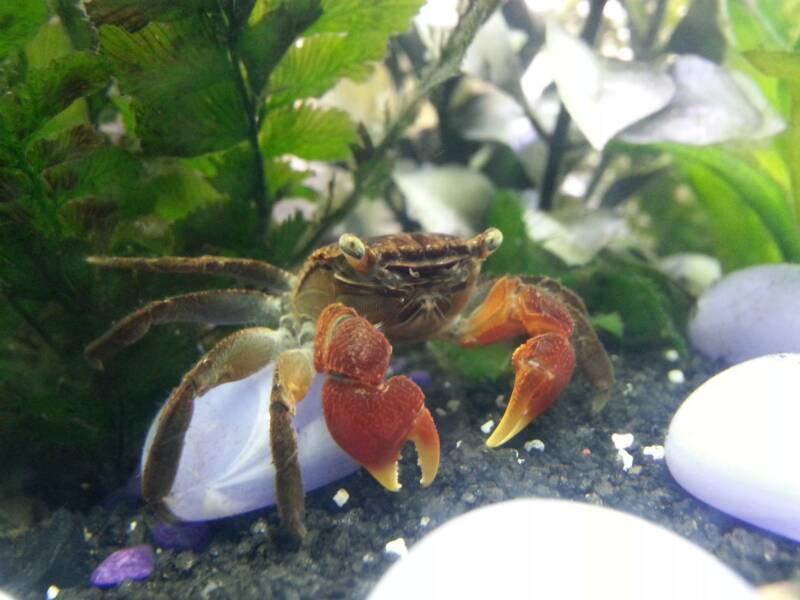Scientifically known as Perisesarma bidens, the red claw crabs make for an intriguing aquarium species. They are fascinating to watch and exciting to own.
Even though they’re often marketed as freshwater crabs, red claw crabs require air and brackish water.
Because of their brackish water requirements, this crab is best for moderate to experienced hobbyists.

They can survive in freshwater tanks but with a shorter life expectancy without some brackish water to live in. The same goes with access to air.
Crabs are decapods with ten legs, the first eight used for walking around their environment.
Red Claw Crabs are primarily dark in color, sometimes with orange and yellow tips.
Their distinguishing feature is bright red claws. You may see some variation of color in terms of vividness.
Colorful and full of character, this care guide reviews how to keep your red claw crabs happy and healthy in an aquarium environment!
At a Glance
| Adult size: | 2-2.5” (carapace) 4” (leg span) |
| Minimum tank size: | 10 gal (38 l) |
| Temperature: | 70-88°F (21-31°C) |
| Lifespan: | 2-2.5 years |
| pH: | 7.5–8.5 |
| Behavior: | Territorial, semi-aggressive |
| Water parameters: | 0 ppm ammonia, 0 ppm nitrite, < 30 ppm nitrate |
[toc]
In the Wild
Red claw crabs can be found in bodies of water throughout Asia.
Hailing from the mangrove swamps of rivers and estuaries, their natural habitat is brackish. These are areas where freshwater flows into the sea, creating a mix of salt and freshwater.
These regions provide shallow, tropical warmer waters for the crabs to live in.
They can be found navigating through the fine, sandy bottoms of these habitats.
Behavior
The red claw crab is somewhat shy, tending to spend their days in hiding and becoming active at night.
As they get increasingly comfortable in their environment, you may see them out more.
However, their temperament is considered aggressive as they are quite defensive. They are highly territorial, although most observed predatory behaviors are often associated with territory, not food disputes.
When a red claw crab is threatened or frightened, they will raise their claws. What comes next is either a retreat or an attack.
They have been known to kill other fish in aquariums, so you’ll want to choose tank mates carefully.
These species will molt as they grow. During this time, they will feel particularly vulnerable and defensive. It’s important to have shelter and hiding spots so your crabs feel safe while their new shell hardens.
Red Claw Crab Tank Setup

A minimum of 10 gallons is required for red claws. This will be suitable for a single male and 2 or 3 females. Since these crabs are territorial, bigger may be better when selecting a tank in this case.
Start your tank set up with a sandy substrate. This mimics their natural environment and is best for this scavenging, burrowing species.
A tank that accommodates both land and water environments is ideal, a paludarium is a unique tank designed specifically for this. If you invest in this type of tank, you’ll want to find one that’s 24 inches wide.
When using a standard aquarium you can still provide your crabs with both land and water to stay happy and healthy. You’ll want to be aiming for a water to land ratio of 3:1.
One simple solution is to build a landmass with sand. You could also purchase floating perches that can serve the same purpose.
Rocks and driftwood will help offer crabs shelter and protection, particularly when they molt. It’s okay to add plants in with your red claw crabs, but be aware they may uproot or rip certain plants.
You should avoid Java ferns, which are a brackish favorite for the crabs. To avoid this issue entirely, synthetic plants, such as ones made of silk, may be the better option.
You’ll want a strong filtration system and a solid lid. For filtration, a marine filter is ideal for cycling water without affecting salinity.
As for a lid, it’s important for preventing escapees, extended periods without water might lead to mortality.
Finally, a 10% water change once a week is recommended for maintaining water quality.
Water Preferences
Water salinity should be around 1.005 for your brackish species. If you’re new to brackish aquarium setups, a salinity meter, and aquarium salt is a good place to start.
Red claw crabs seem to prefer water that’s quite hard, between 8-25 dGH. pH should be kept slightly acidic, around 7.5-8.5.
You’ll want to maintain ammonia and nitrite levels at 0 ppm and nitrate levels should remain around < 30 ppm. It’s important to test these parameters regularly.
Tank Mates & Compatibility
Red claw crabs are best in species-specific tanks for a number of reasons.
Due to their territorial and aggressive nature, they are known to fight.
In addition, their brackish nature makes them difficult to pair with compatible cohabitants.
However, some aquarists do report success in pairing them with brackish water fish such as gobies, flagfish, and mollies.
Food & Diet
Red claw crabs are omnivores, in the wild, they often eat mangrove leaves. This means they may eat at live plants within your aquarium, their claws primed for this kind of cutting and slicing.
More intentionally, they can be fed bloodworms, brine shrimp, and uncooked fish and shrimp.
Red claw crabs will also eat their share of veggies including blanched greens and peas. While you can feed them algae pellets and sinking food tablets, they seem more fond of other food options.
Breeding
Red claws are incredibly difficult to breed in captivity. They produce larvae that are vulnerable to attack yet provide no parental care.
Aquarists have noted that the crabs will spawn in tanks, however, they rarely ever hatch.
Sexing
Identifying your crab’s gender is quite easy. Males tend to have meatier claws and are brighter in color.
With all crab species, you can easily identify an individual’s gender by looking at the underside of their body.
Underneath, there will be a flat flap. Males will have an elongated, pointed flap while females will have a rounded flap.
Some often remember this by comparing the flaps to the Washington Monument and United States Capitol building, as they resemble the male and female flap shapes respectively.
Health and Diseases
Bacterial and fungal infections, as well as parasites, can be contracted by these crabs, however, it is rare. Red claws are known for being relatively hardy.
Stress is one aspect that’s known to increase the likelihood of disease in these crabs. To avoid undue stress, don’t overcrowd your tank and maintain proper water quality.
Closing Thoughts
The red claw crab requires a bit of extra effort due to their brackish nature and desire for both land and water.
This species probably isn’t ideal for beginners, they are much more suited for those with moderate to advanced experience.
However, they are fun crabs to keep due to their unique character and behaviors.
When purchasing your red claw crabs, you can expect to pay about $4 per individual.
If you have additional questions or suggestions, please feel free to reach out.
